Byzantine Hagia Sophia - Anthemios & Isodorus
- Written by Portal Editor
Dating from Byzantine times, the huge architectural monument of Hagia Sophia, also known as the "Great Cathedral", was commissioned by Emperor Justinian I to have been built.
The Hagia Sophia was planned and designed by the architects Isidorus and Anthemios and built in a very short construction period of only 5 years on the ruins of the ancient temple of Apollo in Byzantine style between the years 532 and 537.
Byzantine brick building with a huge dome
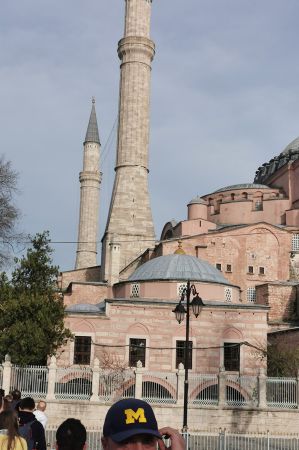 This once beautiful cathedral with its huge dome is built on the highest point in Istanbul with stunning views of the Sea of Marmara and the Bosphorus, is certainly one of the largest and oldest brick structures in the world and despite the earthquakes in some places being violent of the region, it still stands.
This once beautiful cathedral with its huge dome is built on the highest point in Istanbul with stunning views of the Sea of Marmara and the Bosphorus, is certainly one of the largest and oldest brick structures in the world and despite the earthquakes in some places being violent of the region, it still stands.
The dome of the Hagia Sophia, with an original span of 33 meters, remains to this day the largest brick dome in architectural history to be built with only four support points. With the gigantic implementation and the proportions and the special harmony of its interior, it is considered one of the most important buildings of all time. Due to its special building structure and the new idea of penetrating the central space and longitudinal basilica, first realized here by Isidor von Miletus and Anthemios von Tralleis, a building was created that explored the limits of the available technical possibilities of late antiquity. It is one of the boldest man-made constructions and one of the most important structures of the last 1500 years.
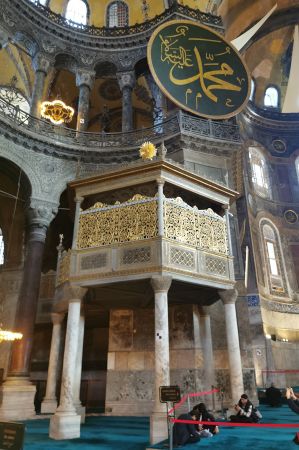 As the last major and by far the most important building of early Byzantine architecture and art of late antiquity, it is seen in its function as a central place of Byzantine representation of power as an embodiment of the Byzantine idea of empire and is therefore one of the key works for understanding the cultural-historical phenomenon of Byzantium. At the same time, it brought about a new paradigm of church building, which in part stood in contrast to its older predecessors and which was subsequently to form one of the cornerstones of Christian architecture, which had a lasting influence on sacred architecture in East and West. The Hagia Sophia was built not least as an expression and demonstration of Justinian's imperial power: by manifesting the uniqueness of its client and the display of his outstanding position in the building, it also forms the claim that Justinian's divine right in earthly rule over the Christian world show off The Hagia Sophia was the cathedral of Constantinople, the main church of the Byzantine Empire and the religious centre of orthodoxy and is today a landmark of Istanbul.
As the last major and by far the most important building of early Byzantine architecture and art of late antiquity, it is seen in its function as a central place of Byzantine representation of power as an embodiment of the Byzantine idea of empire and is therefore one of the key works for understanding the cultural-historical phenomenon of Byzantium. At the same time, it brought about a new paradigm of church building, which in part stood in contrast to its older predecessors and which was subsequently to form one of the cornerstones of Christian architecture, which had a lasting influence on sacred architecture in East and West. The Hagia Sophia was built not least as an expression and demonstration of Justinian's imperial power: by manifesting the uniqueness of its client and the display of his outstanding position in the building, it also forms the claim that Justinian's divine right in earthly rule over the Christian world show off The Hagia Sophia was the cathedral of Constantinople, the main church of the Byzantine Empire and the religious centre of orthodoxy and is today a landmark of Istanbul.
Anthemios of Tralleis and Anthemios
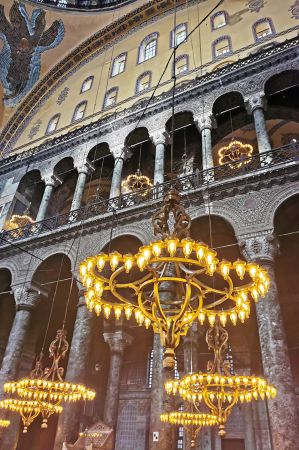 One of the architects, Anthemios von Tralleis, was a late antique mathematician, scholar and architect. Anthemios was the son of a doctor named Stephanos and was considered an excellent mathematician, although he was even more successful as an architect. From 532 to 537 Anthemios built the Hagia Sophia Cathedral in Constantinople together with Isidore of Miletus on behalf of the Eastern Roman Emperor Justinian I.
One of the architects, Anthemios von Tralleis, was a late antique mathematician, scholar and architect. Anthemios was the son of a doctor named Stephanos and was considered an excellent mathematician, although he was even more successful as an architect. From 532 to 537 Anthemios built the Hagia Sophia Cathedral in Constantinople together with Isidore of Miletus on behalf of the Eastern Roman Emperor Justinian I.
As the coronation church of the Byzantine emperors (since 641), as the cathedral of the Ecumenical Patriarchate of Constantinople and the site of important historical events, the Hagia Sophia is associated in a special way with Byzantine history, and generally as a universally conceived model church of the capital of the Christian oicumene, Constantinople, with the history of ideas associated with Eastern Christianity.
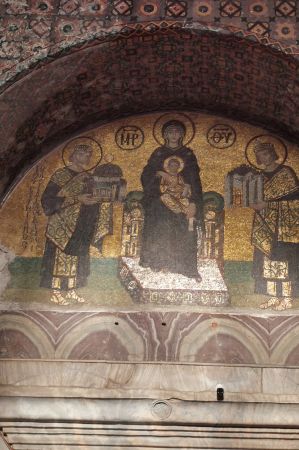 Planned as a building of universal importance, it also remained a universal Christian spiritual center throughout the Middle Ages. On the right side of the naos, the omphalion therefore also symbolizes the center of the earth, the proverbial "navel of the world". However, their construction and their symbolic power were of extraordinary importance, especially for orthodox Christianity and the empire. Therefore, it is still considered a great sanctuary by most orthodox Christians today.
Planned as a building of universal importance, it also remained a universal Christian spiritual center throughout the Middle Ages. On the right side of the naos, the omphalion therefore also symbolizes the center of the earth, the proverbial "navel of the world". However, their construction and their symbolic power were of extraordinary importance, especially for orthodox Christianity and the empire. Therefore, it is still considered a great sanctuary by most orthodox Christians today.
According to the historian Procopius, both architects were in charge of the work. Anthemios made the model and, according to ancient records by Paulos Silentiarios, Anthemios mainly dealt with the foundations. At the time of the dome collapse in May 558, Anthemios was no longer alive.
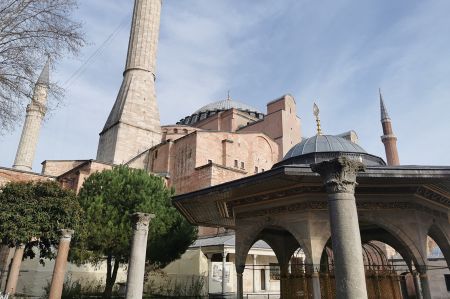 Isidore of Miletus was also a renowned scientist and mathematician. Emperor Justinian I once introduced him as follows: "Isidore teaches stereometry and physics at the universities, first in Alexandria, then in Constantinople, and wrote a commentary on an older treatise on vaulting." Isidore is much better known, however, for the first comprehensive compilation of the works of Archimedes and of course for the construction of Hagia Sophia.
Isidore of Miletus was also a renowned scientist and mathematician. Emperor Justinian I once introduced him as follows: "Isidore teaches stereometry and physics at the universities, first in Alexandria, then in Constantinople, and wrote a commentary on an older treatise on vaulting." Isidore is much better known, however, for the first comprehensive compilation of the works of Archimedes and of course for the construction of Hagia Sophia.
On behalf of Justinian, Anthemios, who was highly praised by Agathias, and Isidor were also entrusted with other tasks. For example, they should find a way to stop the flooding at Dara-Anastasiupolis Fortress.
Conversion into a mosque
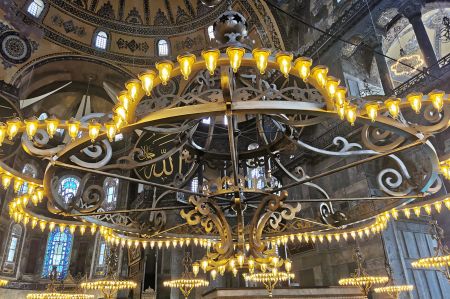 After the Ottoman conquest of Constantinople in 1453, Christian insignia, interior furnishings, decorations and bells of Hagia Sophia were removed or covered by plaster. Subsequently adapted as the main Ottoman mosque, it had a great influence on the development of Ottoman architecture. The Ottoman sultans of the 16th and 17th centuries based the mosques in the great imperial kulliyen on the architectural model of the Hagia Sophia. Major works were created here by Sinan. In general, among the most important early Christian sacred buildings, the Hagia Sophia has changed less from a purely architectural perspective than the great early Christian basilicas of Rome and Jerusalem, despite the fact that it was put into Islamic service.
After the Ottoman conquest of Constantinople in 1453, Christian insignia, interior furnishings, decorations and bells of Hagia Sophia were removed or covered by plaster. Subsequently adapted as the main Ottoman mosque, it had a great influence on the development of Ottoman architecture. The Ottoman sultans of the 16th and 17th centuries based the mosques in the great imperial kulliyen on the architectural model of the Hagia Sophia. Major works were created here by Sinan. In general, among the most important early Christian sacred buildings, the Hagia Sophia has changed less from a purely architectural perspective than the great early Christian basilicas of Rome and Jerusalem, despite the fact that it was put into Islamic service.
At the suggestion of Atatürk, the first President of Turkey, the Council of Ministers decided on November 24, 1934 to convert the mosque into a museum. On July 10, 2020, Turkey's Supreme Administrative Court ruled that Hagia Sophia could be used as a mosque again. By order of Turkish President Recep Tayyip Erdoğan, July 24, 2020 has been set for the first Islamic prayer.
Please also read:
